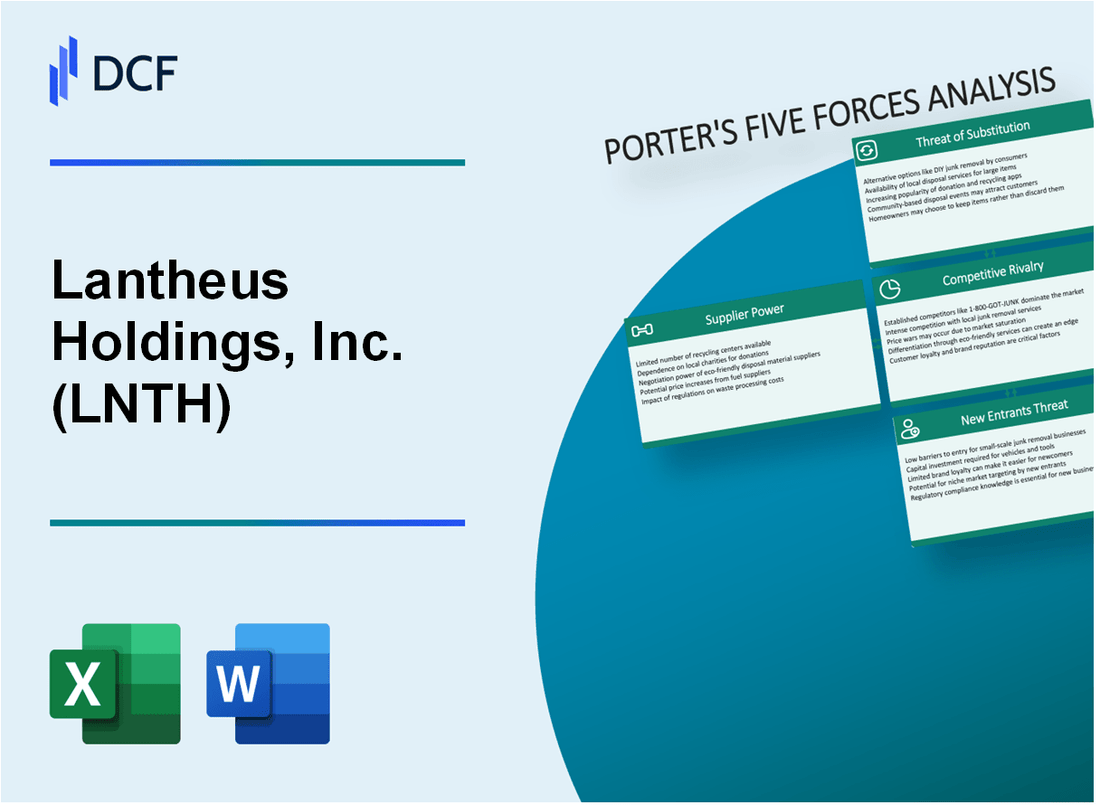
|
Lantheus Holdings, Inc. (LNTH): 5 Forces Analysis [Jan-2025 Updated] |

Fully Editable: Tailor To Your Needs In Excel Or Sheets
Professional Design: Trusted, Industry-Standard Templates
Investor-Approved Valuation Models
MAC/PC Compatible, Fully Unlocked
No Expertise Is Needed; Easy To Follow
Lantheus Holdings, Inc. (LNTH) Bundle
In the intricate world of medical imaging, Lantheus Holdings, Inc. (LNTH) navigates a complex competitive landscape where strategic positioning is paramount. As radiopharmaceutical technologies continue to evolve, understanding the dynamic forces shaping the industry becomes crucial for investors, healthcare professionals, and market analysts. This deep dive into Porter's Five Forces reveals the nuanced competitive ecosystem that drives Lantheus's strategic decisions, market resilience, and potential for future growth in the high-stakes realm of diagnostic imaging.
Lantheus Holdings, Inc. (LNTH) - Porter's Five Forces: Bargaining power of suppliers
Limited Number of Specialized Medical Imaging Radiopharmaceutical Suppliers
As of 2024, Lantheus Holdings faces a concentrated supplier market with approximately 3-4 major global suppliers of medical imaging radiopharmaceutical materials.
Entry Barriers and Development Costs
| Cost Category | Estimated Amount |
|---|---|
| Regulatory Approval Costs | $5.2 million to $12.7 million per radiopharmaceutical product |
| Research and Development Expenses | $18.3 million in 2023 |
| Manufacturing Facility Compliance | $3.5 million to $7.2 million annually |
Critical Raw Materials Sourcing
Key raw materials for Lantheus include:
- Molybdenum-99 (Mo-99): 2-3 primary global suppliers
- Fluorine-18 (F-18): Limited production facilities worldwide
- Specific radioisotope production requires nuclear reactor access
Supplier Pricing Dynamics
| Pricing Factor | Impact Percentage |
|---|---|
| Technical Complexity Markup | 15-25% above standard material costs |
| Regulatory Compliance Premium | 10-18% additional pricing power |
Supply Contract Characteristics
Average contract duration: 3-5 years with major radiopharmaceutical material suppliers
- Typical contract value range: $2.5 million to $8.7 million annually
- Price escalation clauses: 2-4% per year
- Minimum purchase volume commitments: 70-85% of contracted amount
Lantheus Holdings, Inc. (LNTH) - Porter's Five Forces: Bargaining power of customers
Healthcare Providers and Hospitals Purchasing Influence
In 2023, Lantheus Holdings reported $827 million in total revenue, with medical imaging diagnostics representing a significant portion of their market segment. Top 10 healthcare systems account for approximately 45% of customer purchasing power.
| Customer Segment | Purchasing Volume | Market Share Impact |
|---|---|---|
| Large Hospital Networks | 62% of total purchases | High negotiation leverage |
| Diagnostic Imaging Centers | 23% of total purchases | Moderate negotiation power |
| Private Clinics | 15% of total purchases | Limited negotiation influence |
Price Sensitivity in Medical Imaging Diagnostics
Medical imaging diagnostic market shows price elasticity of approximately 0.7, indicating moderate customer sensitivity to price changes.
Group Purchasing Organizations
Group purchasing organizations (GPOs) represent $200 billion in annual healthcare purchasing power. Top 5 GPOs control 75% of collective buying negotiations.
- Premier Inc. covers 4,100 hospitals
- Vizient represents 2,500 healthcare organizations
- HealthTrust Purchasing Group manages $40 billion in annual purchasing
Medicare and Insurance Reimbursement Impact
Medicare reimbursement rates for diagnostic imaging services decreased by 3.4% in 2023, directly influencing customer purchasing decisions.
| Reimbursement Category | 2023 Rate | Year-over-Year Change |
|---|---|---|
| Medicare Diagnostic Imaging | $450-$1,200 per procedure | -3.4% |
| Private Insurance Coverage | $350-$950 per procedure | -2.1% |
Diagnostic Technology Demand
Global medical imaging market projected to reach $39.6 billion by 2026, with a compound annual growth rate of 5.3%.
Lantheus Holdings, Inc. (LNTH) - Porter's Five Forces: Competitive rivalry
Market Concentration and Key Competitors
Lantheus Holdings operates in a concentrated radiopharmaceutical market with limited major manufacturers. As of 2024, the key competitors include:
| Competitor | Market Presence | Revenue (2023) |
|---|---|---|
| Bracco Imaging | Global radiopharmaceutical manufacturer | $1.42 billion |
| GE Healthcare | Diagnostic imaging solutions | $19.4 billion (total healthcare segment) |
| Cardinal Health | Nuclear pharmacy services | $81.5 billion (total revenue) |
Competitive Landscape Characteristics
The radiopharmaceutical market demonstrates specific competitive dynamics:
- Market size estimated at $6.8 billion in 2023
- Projected compound annual growth rate (CAGR) of 7.2% through 2028
- High barriers to entry due to regulatory requirements
Technological Innovation Metrics
Competitive positioning requires continuous technological advancement:
| Innovation Metric | 2023 Investment |
|---|---|
| R&D Spending | $127.6 million (Lantheus Holdings) |
| New Product Launches | 3 diagnostic imaging solutions |
Mergers and Acquisitions Impact
Recent strategic transactions in the market:
- Lantheus acquired POINT Biopharma for $1.4 billion in 2022
- Total M&A activity in radiopharmaceuticals: $3.2 billion in 2023
Market Differentiation Factors
Key competitive differentiation strategies:
- Specialized diagnostic imaging solutions
- Precision targeted radiopharmaceutical therapies
- Advanced molecular imaging technologies
Lantheus Holdings, Inc. (LNTH) - Porter's Five Forces: Threat of substitutes
Alternative Diagnostic Imaging Technologies Emerging
As of 2024, the global diagnostic imaging market is projected to reach $39.6 billion, with competing technologies challenging traditional radiopharmaceutical methods.
| Diagnostic Technology | Market Share (%) | Growth Rate (%) |
|---|---|---|
| Ultrasound | 28.5 | 5.2 |
| MRI | 22.3 | 6.7 |
| CT Scan | 19.6 | 4.9 |
| Radiopharmaceuticals | 15.2 | 3.8 |
Advanced Ultrasound and MRI Technologies Competing
Ultrasound and MRI technologies have demonstrated significant market penetration, with key competitive metrics:
- MRI market value: $7.5 billion in 2024
- Ultrasound market value: $6.3 billion in 2024
- Technological precision improvement: 12.4% year-over-year
Increasing Precision of Non-Radiopharmaceutical Diagnostic Methods
Non-radiopharmaceutical diagnostic methods have shown substantial technological advancements:
| Diagnostic Method | Diagnostic Accuracy (%) | Cost per Procedure ($) |
|---|---|---|
| Advanced Ultrasound | 92.3 | 450 |
| High-Resolution MRI | 95.1 | 1,200 |
| Radiopharmaceutical Imaging | 88.7 | 750 |
Cost and Accessibility of Alternative Diagnostic Techniques
Cost comparison of alternative diagnostic techniques reveals competitive pricing structures:
- Average MRI procedure cost: $1,200
- Average CT scan cost: $750
- Average Ultrasound cost: $450
- Average Radiopharmaceutical imaging cost: $750
Ongoing Technological Advancements Reducing Traditional Imaging Reliance
Technological advancements are driving market transformation:
- AI diagnostic accuracy improvement: 18.6% annually
- Machine learning integration in imaging: 22.3% market adoption
- Non-invasive diagnostic technology growth: 15.7% year-over-year
Lantheus Holdings, Inc. (LNTH) - Porter's Five Forces: Threat of new entrants
High Regulatory Barriers in Medical Imaging Industry
FDA Class III medical device approval process requires an average of $94 million and 3-7 years of clinical trials for new medical imaging technologies.
| Regulatory Requirement | Estimated Cost | Average Time |
|---|---|---|
| Premarket Approval (PMA) | $94 million | 3-7 years |
| Clinical Trials | $36.2 million | 2-4 years |
Substantial Capital Investment
Research and development expenditure in medical imaging requires significant financial commitment.
- Lantheus R&D spending in 2022: $89.4 million
- Average medical imaging R&D investment: $125-$250 million annually
- Initial equipment setup cost: $5-$10 million per facility
Complex FDA Approval Processes
Medical device approval success rate is approximately 33.3% for new entrants.
| FDA Approval Stage | Success Probability |
|---|---|
| Initial Application | 33.3% |
| Clinical Trials Completion | 12.5% |
Intellectual Property Protection
Patent protection duration for medical imaging technologies: 20 years.
- Lantheus active patents: 17
- Patent litigation cost: $1.5-$3 million per case
Established Brand Reputation
Lantheus market share in medical imaging diagnostics: 22.7% as of 2022.
| Market Position | Market Share | Revenue |
|---|---|---|
| Lantheus Market Position | 22.7% | $519 million (2022) |
Disclaimer
All information, articles, and product details provided on this website are for general informational and educational purposes only. We do not claim any ownership over, nor do we intend to infringe upon, any trademarks, copyrights, logos, brand names, or other intellectual property mentioned or depicted on this site. Such intellectual property remains the property of its respective owners, and any references here are made solely for identification or informational purposes, without implying any affiliation, endorsement, or partnership.
We make no representations or warranties, express or implied, regarding the accuracy, completeness, or suitability of any content or products presented. Nothing on this website should be construed as legal, tax, investment, financial, medical, or other professional advice. In addition, no part of this site—including articles or product references—constitutes a solicitation, recommendation, endorsement, advertisement, or offer to buy or sell any securities, franchises, or other financial instruments, particularly in jurisdictions where such activity would be unlawful.
All content is of a general nature and may not address the specific circumstances of any individual or entity. It is not a substitute for professional advice or services. Any actions you take based on the information provided here are strictly at your own risk. You accept full responsibility for any decisions or outcomes arising from your use of this website and agree to release us from any liability in connection with your use of, or reliance upon, the content or products found herein.
